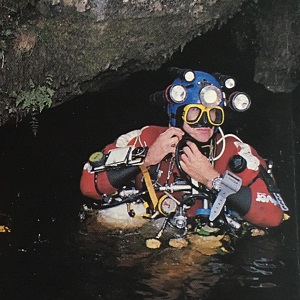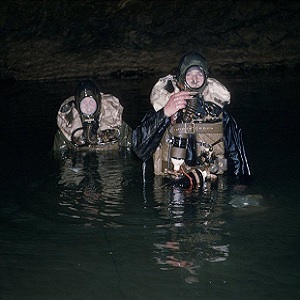The early 1980’s saw renewed pushing at Wookey Hole with Martyn Farr, supported by Rob Palmer & Rob Parker, reaching a depth of 60 metres on compressed air. Advances in equipment, safe practices and our understanding of diving physiology have had a positive impact upon our sport over the last 30 years and permitted exploration in locations where previously, nitrogen narcosis, oxygen toxicity and the sheer logistics of deep open circuit diving have halted progress. Whilst Trimix ( a gas mix containing helium) had already been used a handful of times in the USA, it was first utilised in the UK in 1985 by Rob Parker to a depth of 68 metres in Wookey Hole. Here a sloping gravel floor met the ceiling and Parker could not find the way on. The same year, Trimix was also used by Ian Plant on his dive to 63m in Gavel Pot’s upstream sump.
During 2004 and 2005, a Team led by Rick Stanton and John Volanthen found a route past Parker’s depth limit of 68m in Wookey Hole to establish a new British depth record of 90m. The dives made use of specially manufactured side-mount Closed Circuit Rebreathers and involved clearing submerged boulder chokes at significant depth.
South Wales
In South Wales, major discoveries were made under Llangattock mountain during the mid eighties when on September 8th, 1984, Clive Gardener, Paul Tarrant and Martyn Farr broke through a choke in Ogof Daren Cilau to discover over 2.5 Kilometers of passage. In 1986, this discovery enabled a connection to be made with the resurgence of Pwll Y Cwm in the Clydach Gorge but only after committing exploration in the nearby Elm Hole. At the time this was the longest (5 kilometre) and deepest (213 metre) caving through trip in the British Isles. Attempts to clear the resurgence at Pwll Y Cym started the same year but it was not until 1993 that Duncan Price became the first person to navigate the restriction.
In the late eighties and early nineties, Blane Hepste was extended into sumps 3 and 4 by Andrew Ward and Gareth Hardman and at Tucks rift in the late nineties, “Insane in the membrane” was discovered Andrew Ward & Colin Hayward. In Slaughter Swallet (Wet Sink), Main Stream Sump II was passed to Drakes Series (500 metres of passage) and the terminal sump pushed via two more sumps to gain river passage by Andrew Ward and Gareth Hardman.
Llygad Llwchwr, now a popular tourist destination that benefits from easy access used to entail portering dive gear through the small and awkward, dry entrance above the resurgence until 2003 when, after a protracted effort, CDG members succeeded in clearing an underwater route and providing resurgence access for divers.
Yorkshire Dales
In the Yorkshire Dales, in 1983 the connection was made between Ingleborough Cave and Gaping Gill, Midge Hole was linked to Hurtle Pot by Rupert Skorupka and Johnny Shaw and upstream Hurtle was explored by Geoff Yeadon to 35m depth and 500m penetration. After the discovery by John Cordingley, in 1990, of a potential connection between Keld Head and East Kingsdale (Cobble Inlet) a major push to make a physical connection commenced with Rupert Skorupka exploring downstream from King Pot and John Cordingley, Geoff Yeadon, Geoff Crossley and Russell Carter laying line upstream past Cobble Inlet. On 7th June, 1991 the two lines were joined and on 3rd August, 1991, Yeadon and Crossley made the 3000 metre through trip between King Pot and Keld Head. Attention was also turned to making the connection from Keld Head with Marble Steps Pot to the west. Doing so would add Keld Head into the Three Counties System. This is an ongoing project with John Cordingley laying line in low, silty passages over 1,400 metres into the Keld Head system.
In May, 2010 Chris Jewell pushed beyond Dave Ryall’s limit in upstream Deep Well in Gaping Gill reaching a point 410 metres from base, most of the depth being around 40m.
In May, 2011, Tony Seddon explored Lancaster Hole downstream sump for 840m to a depth of 35m using a chest-mounted semi-closed rebreather and by June, 2013 John Cordingley continuing his careful examination at the ends of Keld Head’s Marble Steps Branch, reaching a point some 1400m from the entrance, and enticingly, less than 300m away from Large Pot and the fabled Three Counties System.
Derbyshire
In Derbyshire at P8 (Jackpot) a deadlock of 16 years was finally broken in 1987 when changing silt deposits allowed Rick Stanton to pass the 183 metre long sump at the bitter end to gain access to dry passage and a further sump (10), blocked at 6 metres depth. Stanton’s limit has only been passed recently (2016) by Ash Hiscock and Josh Bratchley. Following access issues, Peak Cavern was opened to divers in 1980 and CDG divers passed Ink Sump (180 metres). Exploration was also carried out beyond 385 metres of diving in the Far Sump Extensions, initially by Martyn Farr and subsequently by John Cordingley. In the late 198’s, Speedwell Main Rising was explored by John Cordingley and Russell Carter With RC reaching a depth of 26 metres in the Doux de Casterton in 1989, roughly 185 metres from dive base. The bottom of this 70 metre deep shaft was finally reached in 2002 by Martin Groves with support from Rich Hudson. The same point was reached by John Volanthen in 2006 and the sump is currently being inspected by CDG diver, Ben Wright.
International Cave Exploration
During the late nineties and early noughties the ready availability of recreational Closed Circuit Rebreathers, Diver Propulsion Vehicles and improved peripheral equipment enabled a surge of interest in the sumps of the Lot & Dordogne regions of France. In May 1998, in the Emergence du Ressel, Rick Stanton (after passing the 1890 m long and 75 m deep sump 1 on open circuit) explored 120m of dry passage and discovered Sump 2 – three days after two German divers had passed Sump 1 and declared that it closed down. In the following August, Jason Mallinson dived to sump 5 accompanied by Rick Stanton to sump 3 after 2 night bivouac beyond sump one. The next year, using Closed Circuit Rebreathers, the pair dived sump 5 for 1300m to a boulder choke that blocked the continuation. In 2011, Rick Stanton and John Volanthen returned to add 800m of line to a side tunnel discovered in 2000.
In the summer of 2002, Clive Stell, Tim Chapman, Marcel Hattemann and Martina Maier succeeded in digging a way through the restricted entrance series of the Marchepied and dived sump 1 for 670 metres. In 2006, Peter Mulholland and Nadir Lasson, re-opened the entrance which had partially collapsed and over the next year the entrance was stabilised. In 2008, Rick Stanton reached the current limit of exploration of 1338 metres at a depth of 69 metres.
In 1990, Olivier Isler passed the first sump (2340 metres) in the Cogol Dei Veci near Valstagna, Italy but was unable to explore the dry passage beyond because he could not de-kit and leave the water. In 2004, Rick Stanton and John Volanthen, employing a more flexible approach to de-kitting passed the sump and explored 200 metres of dry passage to reach sump 2 in which, they laid 240 metres of line. The next year they returned for a three day exploration during which they bivouacked beyond sump 1 and passed sump 2 after 1090 metres. Further progress was halted by a 40 metre high waterfall.
In August, 2005 Rick Stanton penetrated the resurgence at St Sauveur for 720 metres to reach a depth of 133 metres and in 2012, John Volanthen, Martin Groves & Rupert Skorupka explored the Font Del Truffe ending after sump 14 in an area of narrow breakdown.
World records are being beaten at Pozo Azul in northern Spain. Initially “Discovered” by Rupert Skorupka a Team including Jason Mallinson, Rene Houben, Rick Stanton and John Volanthen have over the course of several expeditions between 2009 & 2017, explored the cave through over 9.4km of diving with the longest sump (2) being 5160 metres in length. Pozo Azul is currently the longest cave dive penetration in the world.
Also in 2013, an expedition to the Mexican Sistema Huautla led by Chris Jewell & Jason Mallinson used closed circuit rebreathers to push sump 9 to a water depth of 81 meters establishing the 1545 meter total depth. Three years later in 2016 a Team led by Chris Jewell found a total 1.2 kilometres of cave, taking the total cave length to 2.33 kilometres. Fifteen dives were conducted to a depth of 65 metres and a duration of four hours. In 2017 a total 1.5 kilometres of cave was found, taking the total cave length to 3.8 kilometres.
It cannot be denied that the Cave Diving Group continues to play a pivotal role in cave exploration not just in the UK but internationally.
Footnote
All this talk of Trimix, rebreathers, scooters and epic underwater explorations may cloud the memory as to the raison d’être of the Cave Diving Group of Great Britain and Northern Ireland: To lay new line and explore UK caves.
In addition to the names of legend that appear over and over again in our three historical chapters there are many others with their own, may be less glamorous projects that form the very core of what the CDG do. Take for example the Northern Section Trainees who are digging underwater in Cumbria in the hope of joining a substantial cave into the Three Counties System or, Alex Fletcher who is digging out a restricted sump that points towards a big black hole in the cave map of the Dales. Wigmore Swallet, one of the most distinct feeders to the Cheddar Risings, has been explored in atrocious visibility and often constricted conditions, before several sumps were bypassed in 2015. Exploration currently stands at sump 11 with no sign of it giving in easily. Ben Wright is laying new line in the Lost River series of Gaping Gill with the intention of making the link with Deep Well and in January, 2017, a Team lead by Derbyshire cave diver Jim Lister, after 16 years of continuous work, finally breached the boulder choke in the roof of the Doom’s Retreat Aven beyond Ink sump.
The hard truth of cave diving British style is that new line is more often laid by the foot rather than the kilometre.
Steve Robinson, November 2017.

Advances in equipment, safe practices and our understanding of diving physiology have had a positive impact upon our sport over the last 30 years.
Learn more
Related Articles
CDG Cave Exploration – 1980’s to Present
From the 80's through to the present the CDG continue to lay line and discover new cave passage both in the UK and internationally.
CDG Cave Exploration – The Golden Age
Cavers embrace the use of open circuit equipment, develop safety innovations and explore deeper and further into cave systems across the UK.
CDG Cave Exploration – Beginnings
Cave diving in the United Kingdom did not originate or develop in isolation from caving. Cavers learnt to dive; cave divers did not become cavers.



